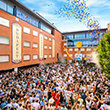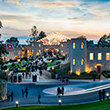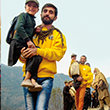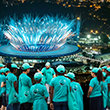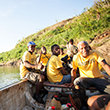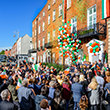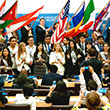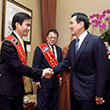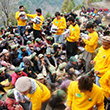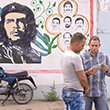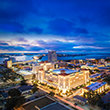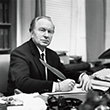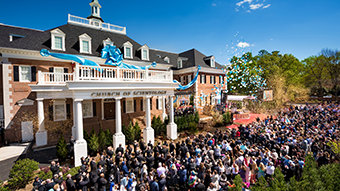“Vision.” The word denotes “unusual discernment or foresight,” according to one dictionary. Another definition describes “a thought, concept or object formed by the imagination.”
Vision, transformed into decisive action, became manifest in the heart of the American South on April 2, 2016, staking out turf in Atlanta, Georgia. The vision garnered multi-dimensional worldwide substance on May 28 in Hollywood, California and continued its progress on June 25 in Clearwater, Florida. Then Budapest, Hungary welcomed the vision on July 23, as did Harlem in New York City on July 31, accompanied by a jazz melody. Extending across the globe, the vision materialized in Sydney, Australia, on September 4. Spanning the planet again, the vision was planted in Dublin, Ireland, on October 15.
That vision was first enunciated by the Founder of the Scientology religion, L. Ron Hubbard. He described the optimum Church of Scientology as a place “where people came to achieve freedom and where they had confidence they would attain it. … One could look at this [Church] and know that this was the place a new civilization was being established for this planet.”
Carrying out that vision today is another man, David Miscavige, the ecclesiastical leader of the religion. His commanding stewardship of the Church for the last three decades has turned Mr. Hubbard’s vision into decisive action.

Another word: “Expansion” is “the act or process of expanding,” the dictionary states. Take the combination of the two words—“vision + expansion”—and that’s the 2016 equation for the Church of Scientology. The vision first articulated by Mr. Hubbard and the expansion of the religion as captained by Mr. Miscavige have defined 2016 by another word: “accomplishment.”
The mission Mr. Hubbard established for Scientology, born in the early Atomic Age, was to ensure mankind’s and the planet’s survival in the face of a volatile and descending civilization. In the current tumultuous age, Scientologists, to a person, are driven by a purpose to reverse humanity’s plight. Vision + expansion are the ingredients needed for that success.
Mr. Hubbard was a man of action in many fields, a communicator in many media. And the religion he founded had two primary goals: releasing all people from the mental and spiritual chains that enslave them; and creating a new civilization embodying the highest aspirations of those liberated, enlightened people.
“A civilization without insanity,” wrote Mr. Hubbard, “without criminals and without war, where the able can prosper and honest beings can have rights, and where Man is free to rise to greater heights, are the aims of Scientology.”
Through the last six decades, those goals have steadily become reality, because vision + expansion were the agenda. The year 2016 added to that calculation and followed previous years where new Churches—including the 2013 inauguration of the religion’s worldwide cathedral, the Flag Building, in Clearwater—opened at an accelerating rate. Those new Churches expanded the religion’s well-known and potent humanitarian programs: defending human rights; battling the scourges of predatory psychiatry; teaching people the truth about narcotics and addiction; sending out teams of Volunteer Ministers to ease suffering around the world; turning ex-cons into productive citizens; and inspiring entire populations through the introduction of common-sense moral and ethical guideposts.
And each new Church fostered new missions, which in turn are becoming full-service Churches.
Put another way: vision + expansion = an uplifted humanity.
Nothing illustrates that more than what transpired on May 28 in Hollywood. A 1912-vintage movie studio was reopened as Scientology Media Productions (SMP). It’s a spectacular fusion of technology and restoration—the Church’s epicenter for broadcasting, online and magazine publishing, special events and more. But all of that doesn’t begin to describe the “why.” As Mr. Miscavige affirmed to the 10,000 celebrants at the opening, SMP is the voice of Scientology. It will broadcast, post, beam and publish the religion’s message of hope. “We’re now going to be writing our own story,” Mr. Miscavige proclaimed, “like no other religion in history.”
SMP completed a broader design to tell the world about Scientology. In recent years, Bridge Publications in Los Angeles and New Era Publications in Denmark have kept digital presses rolling, sending Mr. Hubbard’s works to every corner of the globe. Meanwhile, the Church’s Dissemination Center in Los Angeles provides the materials critical for the many humanitarian programs of Scientology. SMP now adds broadcasting, online and magazine publishing to the media arsenal.
Mr. Hubbard’s vision of Scientology Churches included an aesthetic dimension, and the buildings Mr. Miscavige has guided into existence are stunning. But the true purpose wasn’t beauty. The concept was based on the first model—the early worldwide headquarters of Scientology at L. Ron Hubbard’s home, Saint Hill in East Grinstead, England.
After the September 11, 2001, terrorist attacks on America, Mr. Miscavige issued a “Wake-Up Call” to the religion. “Our responsibilities extend far beyond immediate help” to a ravaged New York City, he wrote. “It is an urgent mission. Of that, let there be no doubt. And the only means to accomplishing that are … tens of thousands of missions and thousands of Churches.”
The vision in that “Wake-Up Call” could only become solid reality if Scientology grew at increasingly faster rates since its founding in 1954. Critical to that growth were two massive projects directed by Mr. Miscavige. First was the full restoration of Mr. Hubbard’s entire legacy of Dianetics and Scientology writings and recorded lectures. Simultaneous to that, Mr. Miscavige researched deep into what the Founder had conceived as the strategy for Churches: Which facilities were required for a Church to fully achieve its purpose; how the design would facilitate members’ education and religious services; how many people were needed to staff a Church. Plus, how each Church would serve as a hub for neighboring communities to nourish humanitarian crusades.
The first such model Church came to fruition in Johannesburg, South Africa, opening in November 2003. The number is now 55; and to it are added scores of other buildings and facilities, all reflecting Mr. Hubbard’s early concepts and Mr. Miscavige’s direction.
They range from Church-sponsored, secular Narconon addiction treatment centers, to advanced Churches for Scientologists reaching the top levels of spiritual development, to operations centers for the Church’s many societal salvage campaigns, to office buildings where more staff serve more and more Scientologists and the community at large.
In 2016, new Churches were greeted with gala fêtes in cities from Atlanta and Harlem to Budapest.
A new, massive advanced Church in Sydney is a spark plug for growth in Australia and Asia Pacific nations. Landmark office buildings in Clearwater now accommodate the burgeoning staff and operations at the Scientology spiritual capital.
A National Affairs Office in Dublin stands to accelerate humanitarian programs on the Emerald Isle.
More than 50 new Churches are planned and underway, to open in the next two years, and Mr. Miscavige says that estimate is “conservative.”
Vision + expansion = humanity’s survival, the flourishing and prospering of a grand civilization.







